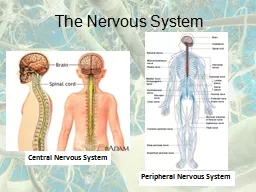

The Nervous System Central Nervous System Peripheral Nervous System Procedure A starting person will be chosen and will be given an object Once the teacher gives the signal the start person will pass the object to their right ID: 768919
Download Presentation The PPT/PDF document "The Nervous System Central Nervous Syste..." is the property of its rightful owner. Permission is granted to download and print the materials on this web site for personal, non-commercial use only, and to display it on your personal computer provided you do not modify the materials and that you retain all copyright notices contained in the materials. By downloading content from our website, you accept the terms of this agreement.
The Nervous System Central Nervous System Peripheral Nervous System
Procedure A starting person will be chosen and will be given an object. Once the teacher gives the signal, the start person will pass the object to their right. Each student will take the object and pass it to their right until it makes it back to the starting person.
Procedure DO NOT THROW THE OBJECT! A time will be recorded for each trial Repeat the process 2 more times and record the times in your spiral.
Questions In your spiral, answer the following questions about the demonstration.
Organs of the Nervous System The nervous system consists of: brainspinal cordnerves neuronssense organs
The Neuron
The Brain
Functions of the Nervous System Your nervous system is a communications network Receiving informationResponding to stimuliMaintaining homeostasis
Receiving Information Because of your nervous system, you are aware of what is happening in the environment around you Your brain is also aware of your internal conditions like temperature and glucose level
Responding to Stimuli After receiving information, your nervous system analyzes the data and causes a response Putting your hand in front of your face if a ball is coming at youIncreasing your heart rate when exercising
Maintaining Homeostasis The nervous system maintains homeostasis by directing the body to respond correctly to the information it receives When you are hungry, your brain tells you to eat
Central Nervous System The control center of the body Composed of your:Brain – controls most functions Spinal Cord – thick column of nerve tissue that links the brain to nerves in the peripheral nervous system
Brain The brain contains 100 million neurons The skull, layers of connective tissue, and fluid protect the brain from injuryThe brain is composed of three main parts CerebrumCerebellumBrain stem
Cerebrum Largest part of the brain reads input from the sensescontrols skeletal musclesIn charge of learning, remembering and making judgments
Cerebrum Right side controls left side of bodycontrols creativity and artistic abilityLeft side controls right side of bodyControls math, speech, writing, and logic
Cerebellum Second largest part of your brain Coordinates actions of your musclesHelps you keep your balance
Brain Stem Lies between the cerebellum and spinal cord Controls involuntary actionsBreathingHeartbeat
Spinal Cord The link between your brain and peripheral nervous system Protected by bone, connective tissue and fluid
Peripheral Nervous System Consists of a network of nerves that branch out from the central nervous system Made up of 43 pairs of nerves12 begin in the brain31 begin in the spinal cord One nerve in each pair goes to the right side and one to the left
The Neuron Neurons are cells that carry information around your bodyNerve impulse - The message a neuron carries
The Neuron The cell body of the neuron has two extensions Dendrite – carries impulses to the cell bodyAxon – carries impulses away from the cell body The nerve impulse begins in the dendrite, moves to the cell body then moves down the axon
The Neuron signal goes from axon to dendrite
Kinds of Neurons Different kinds of neurons perform different functions Sensory neuronsInterneuronsMotor neurons
Sensory Neuron Picks up stimuli from the internal or external environment and converts each stimulus into a nerve impulse The impulse travels along the sensory neuron until it reaches an interneuron in the brain or spinal cord sensory impulse travels at 76.2 m/s
Interneuron Neuron that carries nerve impulses from one neuron to another Can pass stimuli from sensory neuron to motor neuron
Motor Neuron Send an impulse to a muscle and the muscle contracts in response Motor impulse travels at 119 m/s
How a Nerve Impulse Travels Millions of nerve impulses travel your body each day The nerve impulse travels along the neuron in the form of electrical and chemical signals
There are tiny spaces or synapses between a neuron and the next structureA nerve impulse must jump this gap Axon tips release a neurotransmitter that allows the impulse to travel the gap How a Nerve Impulse Travels
How a Nerve Impulse Travels Drugs and alcohol can affect the neurotransmitters alcohol increases reaction time depressants, like marijuana also increase reaction time stimulants, like meth, decrease reaction time
The Path of a Nerve Impulse
Reflex A reflex is an automatic response that occurs very rapidly and without conscious controlReflexes protect us from pain and injury
Reflexes
Body systems that work with the nervous system; The nervous system works with every system in the body
Comparing Cells to the Body The cell part that controls the cell is the nucleus